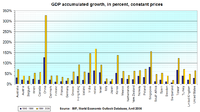
Photo from wikipedia
Background Since the current commonly used birth growth curves are unsuitable for neonates in high-altitude areas; this study aimed to establish birth growth curves for full-term neonates residing at 2,000–3,000 m.… Click to show full abstract
Background Since the current commonly used birth growth curves are unsuitable for neonates in high-altitude areas; this study aimed to establish birth growth curves for full-term neonates residing at 2,000–3,000 m. Methods This cross-sectional study retrospectively analyzed the physical measurement data of 1,546 full-term neonates delivered at the Red Cross Hospital of Qinghai province, China, from July 2021 to April 2022. The percentile curves of birth weight, length, and head circumference of neonates of different gestational ages and genders were developed using curve fitting. The newly developed birth-weight percentile reference was compared with the INTERGROWTH-21st Neonatal Growth Curve (International Standard) and the Chinese Neonate Growth Curve (Chinese Standard). Results The median birth weight, length, and head circumference of the study population were 3,200 g, 52.0 cm, and 32.8 cm, respectively, except for the group with a gestational age of 37 weeks. The growth indicators of male infants in all groups were higher than those of the female infants (P < 0.05). We found differences between the newly developed birth-weight percentile curves in the high-altitude areas and the International and Chinese Standards. Conclusion Establishing birth growth curves corresponding to altitude may be more suitable than the existing standards for local medical staff to conduct health assessments of neonates.
Journal Title: Frontiers in Pediatrics
Year Published: 2023
Link to full text (if available)
Share on Social Media: Sign Up to like & get
recommendations!